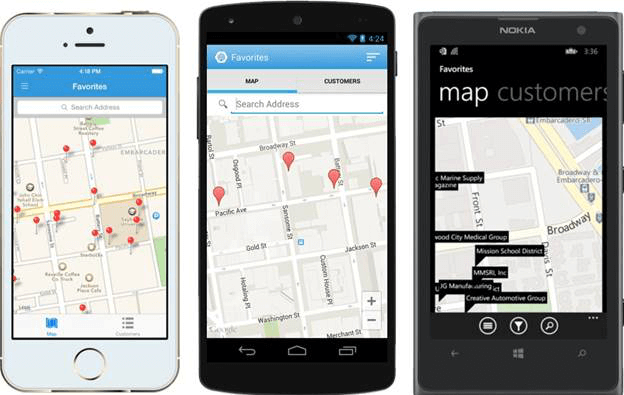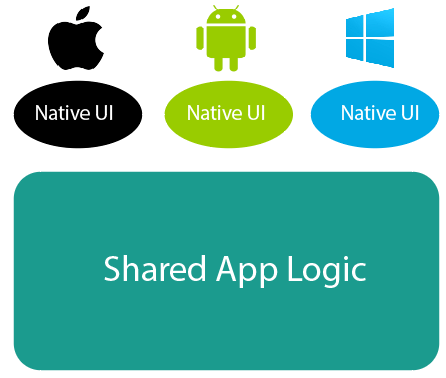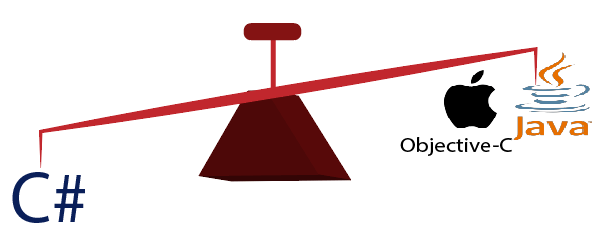Xamarin Introduction
Xamarin is a software company started in 2011. Microsoft recently acquired Xamarin in 2016. Xamarin provides a wide range of tools to the developer that can be used for the development of the cross-platform mobile application.
It is a framework to develop a cross-platform mobile application using the C#. There are various frameworks, which offer the cross-platform app development. They use HTML and JavaScript. With the help of this framework, we can develop apps like a website for a mobile app using JS libraries. Website is packed in a container which gives the feel of a native app.
Xamarin is different because it offers a single language C# and runtime, which works on three mobile platforms (Android, iOS, and Windows). Through Xamarin, we develop a mobile app whose look and feel is entirely native. In Xamarin, we write one C# codebase which has access to all the features of native SDK.
To download with Visual Studio, Xamarin tools are readily available. To use Xamarin on Windows, we need to install Visual Studio, which could be a free version or a premium license. After it, we need to configure it.
Cross-Platform
For mobile, tablet, and desktop applications, Xamarin provides a cross-platform development solution.
Building the mobile apps can be easy as opening up the IDE, writing and testing an app and submitting to an app store. It involves a process that involves the up-front design, Usability testing, QA testing on thousands of devices, a full beta lifecycle, and then deployment in several different ways.
When we think about how to build Android and iOS application, many people believe that the native language, objective-C, Swift, Java, and Kotlin are the only choice.
Xamarin allows us to develop in C# with a class library and runtime which works across all many platforms including ios, Windows, and Android.
Xamarin combines all the abilities of the native platforms and adds several powerful features of its own, which are:
1) Complete binding for the SDKs: Xamarin contains the binding for the entire SDKs on both Android and iOS. These bindings are strongly typed, which means they are easy to navigate and easy to use. Xamarin provides robust, type checking during the compile-time as well as during the development. It leads to lessening runtime errors and higher quality apps.
2) Objective-C, Java, C, and C++ interop: Xamarin provides facilities to directly invoke Objective-C, Java, C, and C++ libraries. It gives us the power to use a wide array of 3rd party code which has been already created. With this, we can take advantage of the existing iOS and Android libraries written in Objective-C, Java, or C/C++. Additionally, Xamarin offers binding the projects which allow us to efficiently attach the native Objective-C, and Java libraries using the declarative syntax.
3) Modern Language Constructs: Xamarin applications are written in C#. C# is a modern language which includes significant improvements over Objective-C and Java. It consists of the *Dynamic Language Features, Functional Constructs such as *Lambdas, *LINQ, Parallel programming feature, sophisticated *Generics and more.
4) Amazing Base Class Library: Xamarin applications use the .NET BCL. An extensive collection of classes which have comprehensive and streamlined features such as powerful XML, Database, Serialization, String, IO, Networking support, and many more. Existing C# code can be compiled to use in an app, which provides access to thousands of libraries that allows us to do the things which aren’t covered in the BCL.
5) Modern Integrated Development Environment (IDE): Xamarin uses Visual Studio on Windows, Visual Studio for Mac on macOS and. These both are modern IDEs. These include features such as code auto-completion, a sophisticated project, and solution management system, a comprehensive project template library, integrated source control, and many others.
6) Mobile Cross-Platform Support: Xamarin offers sophisticated cross-platform support for the three major mobile platforms of iOS, Android, and Windows. The application can be written to share up to 90% of their code. The mobile library offers a unified API to access shared resources across all the three platforms as it reduces both the development cost as well as the time to market for mobile developers. It targets the three most popular mobile platform.
Xamarin is the most powerful and comprehensive feature set is to fill a place for the application developer. They want to use a modern language and platform to develop cross-platform mobile applications.
Need of Xamarin
Xamarin combines all the power of the native platform and also includes its own features.
- Xamarin applications are developed using C#. C# is a modern language which has many improvements over Objective-C and Java.
- Xamarin provides the facility to include Objective-C, Java, and C++ libraries directly. It gives us the ability to reuse all the 3rd party codebases, which are Java, Objective-C, or C++.
- Xamarin offers cross-platform support for the three major mobile platforms (Android, iOS, and Windows). The application can share 90% of their codebase.
- Xamarin reduces the time and cost of mobile app development.
- Xamarin provides a massive collection of class libraries.
- Xamarin provides robust compile-time checking. It will lead to fewer runtime error and high-quality applications.
Working of Xamarin
Xamarin offers two commercial products: Xamarin. Android, Xamarin.iOS. Both are built on Mono, an open-source version of the .NET framework which is based on the published .NET ECMA standard. MONO has been around almost as long as the .NET framework itself and runs on every imaginable platform including Linux, Unix, FreeBSD, and macOS.
Xamarin has wholly converted the Android and iOS SDK to C# to make it familiar to the developer. We can easily use the same CodeBase for both the platform without the difficulty of remembering the syntax of the different languages all the time. And the User Interface remains the same. Xamarin separately built for both the platform and then has to be bounded by the shared codebase. Here are the two ways for creating the User Interface. First one is to use the original native method to build the UI. Another one is to use the Xamarin.Forms. These forms can be used to make the UI for different platform all at once and have 100% code sharing if they are chosen over Native UI technology. When all the UI work completed, the most challenging phase is to connect the UI to the codebase. This connection can be implemented again using the two code sharing approaches, which are:
- Shared Project
- Portable Class Libraries (PCL).
Features of Xamarin
- Xamarin supports wearable devices such as Android Wear and Apple Watch. The functionalities of these wearable devices in their native application are included by downloading the simple plugins from the XamarinCo Component Store.
- Popular Plugins are Cross-Platform, such as Text-to-speech and battery status. Platform-specific plugins too are available in Xamarin component store such as the Google Play billing support plugins.
- The Xamarin based cross-platform applications can easily be united to most of the popular backend platform such as Parse, Microsoft Azure, etc.
- Applications indexing in Xamarin allows those applications to be in search results, which are usually gets forgotten after a few uses from the users.
Xamarin Mobile Application Development offers a thinkable cross-platform solution which works across multiple operating systems and devices. Since it was launch, Xamarin is used as a robust cross-platform app development platform that helps to build a single app for all the device systems. However, Xamarin App Development has both Advantages and Disadvantages:
Advantages of Xamarin
1) Fast App Development Cycle
The most crucial part of Xamarin App Development platform is that it contains the reusable code, 90% of which can be recycled for the development of apps on various platforms. The coding is based on C# language and .Net libraries. Since developers can reuse a great portion of original Xamarin codes for creating apps across different platforms. Due to simplified code sharing across different OS, Users have a shortened Product development lifecycle.
2) ative Applications
The solution for any application is native design. That is when Xamarin and its unique approach comes into existence. Xamarin Studio provides the advantage of Native UI, access to specific device features and most importantly, native performance. Sharing the code between the different platform is an easy task, which helps us to shorten the development lifecycle.

3) Shared App Logic
Apart from Native UI, the most powerful feature of Xamarin is shared, the app logic, which makes it is the most useful and most-usable cross-platform development tool. Application Logic underlying the UI layer like input validation, web service calls, database interactions, and backend enterprises integrations are coded once in C#. Developers can share 75% of the code across the various operating system. It saves the time to record in the applications, and there are fewer chances of the bugs.

4) API Integration
Xamarin binds the same APIs and UI controls which are used to build the iOS, Android, and Mac apps in their respective platform-specific language. For Windows development, Xamarin with Microsoft Visual Studio offers windows phone and windows applications. Code is shared between iOS, Android, and Windows using the Portable Class Library (PCL) and appropriate application architecture. With Xamarin, support is always there. These unique binding technologies enable us to to provide the support for the new feature as soon as they come in the device’s operating system. Click on the respective platform links for their latest support packages for iOS 8 and Android L(with wearable support).
5) Xamarin Component Store
Xamarin believes in Collaboration and Component sharing. The developer chooses from the host free or paid component, which includes UI controls, cross-platform libraries, and third party web services to apps with just a few lines of code. The component store is built in the Xamarin Studio and Xamarin’s Visual Studio extensions.
6) Advantages of C#
C# is a simple, modern, general-purpose, type-safe, pure object-oriented programming language. Being the object-oriented, it is the modern version of C++, which allows the simple data types as objects. The type safety of C# helps to prevent the type errors. Its simplified syntax allows the use of pointers and headers. Namespace and reference operator is replaced by the period. C# is a great programming language for cross-platform development.

Disadvantages of Xamarin
1) Unavoidable Software Overheads
Despite all the facts that Xamarin Mobile Application Development saves time by creating a single app for all the platform. On the other hand, it also involves in the linkage of the code and references between the target OS environment of different devices in use, and .Net frameworks show that this increases the time taken in the initiation and in downloading the apps.
2) Time-Consuming Nature of UI development
Time becomes an essential thing in UI development on the platform of Xamarin. Xamarin offers the facility to reuse the code across the target of the device platform. It is hard to create a portable version of the core UI. That is why Xamarin App Development experts thoroughly perform some portion of coding for an independent platform, which is a time-consuming process.
3) Issues of App file size
With consuming more time, Xamarin takes more space in storing the app file size because of the usage of the general use of Xamarin’s core libraries and functionality of the app stores with the wrong app file size. The size margin in the store may range from 3MB to 15MB.
Conclusion
Xamarin is also known as the king of cross-platform app development. The rich features and resulting benefits of all points towards the cross-platform native applications. In addition to the advantages of the Xamarin, it boasts up the ever-growing community of 70,000 plus developers who are continuously collaborating and enhancing the software.
